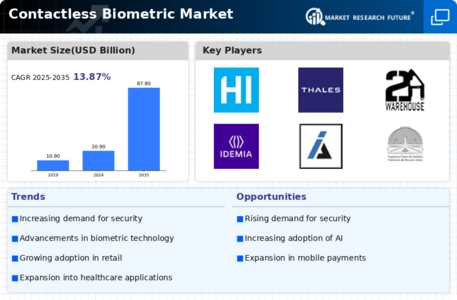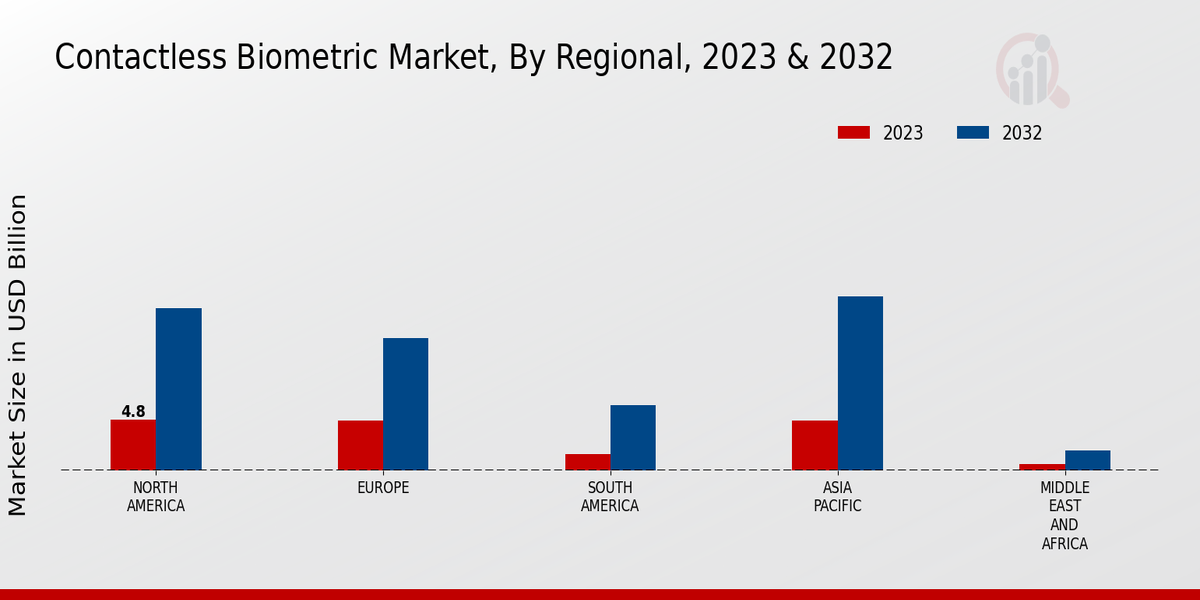Market Growth Projections
The Global Contactless Biometric Market Industry is poised for substantial growth, with projections indicating a market value of 20.9 USD Billion in 2024 and an anticipated increase to 87.8 USD Billion by 2035. This growth trajectory suggests a compound annual growth rate of 13.93% from 2025 to 2035, driven by various factors such as technological advancements, rising demand for contactless solutions, and increasing security concerns. The market's expansion is likely to attract investments and foster innovation, leading to the development of more sophisticated biometric systems. As the industry evolves, it may redefine standards for security and identification across multiple sectors.
Government Initiatives and Regulations
Government initiatives and regulations significantly influence the Global Contactless Biometric Market Industry by promoting the adoption of biometric technologies for security and identification purposes. Various governments are implementing policies that encourage the use of contactless biometric systems in public services, border control, and law enforcement. For example, initiatives aimed at enhancing national security often include the integration of biometric identification systems at airports and immigration checkpoints. As these regulations become more widespread, they are likely to drive market growth, ensuring that biometric technologies are not only adopted but also standardized across different regions, thereby enhancing interoperability and user trust.
Rising Demand for Contactless Solutions
The Global Contactless Biometric Market Industry experiences a notable surge in demand for contactless solutions, driven by the increasing need for hygienic and efficient identification methods. As organizations and institutions seek to minimize physical contact, technologies such as facial recognition and palm vein scanning gain traction. In 2024, the market is projected to reach 20.9 USD Billion, reflecting a growing preference for non-invasive biometric systems. This trend is particularly evident in sectors like banking, healthcare, and security, where rapid and accurate identification is paramount. The shift towards contactless solutions is likely to reshape the landscape of biometric technology, fostering innovation and investment.
Growing Concerns Over Security and Fraud
The increasing concerns over security and fraud are pivotal drivers of the Global Contactless Biometric Market Industry. As cyber threats and identity theft incidents rise, organizations are compelled to adopt more secure identification methods. Contactless biometric systems, such as fingerprint and facial recognition, offer enhanced security features that traditional methods cannot match. This heightened focus on security is particularly evident in financial institutions and e-commerce platforms, where protecting sensitive information is critical. The market's growth is further supported by the projected increase in market value to 87.8 USD Billion by 2035, highlighting the urgent need for advanced security solutions.
Technological Advancements in Biometric Systems
Technological advancements play a crucial role in propelling the Global Contactless Biometric Market Industry forward. Innovations in artificial intelligence and machine learning enhance the accuracy and speed of biometric systems, making them more appealing to various sectors. For instance, improvements in facial recognition algorithms enable real-time identification in crowded environments, which is particularly beneficial for security applications. As these technologies evolve, they not only increase user acceptance but also expand the potential applications of contactless biometrics. This evolution is expected to contribute to a compound annual growth rate of 13.93% from 2025 to 2035, indicating a robust future for the industry.
Integration of Biometric Technology in Consumer Electronics
The integration of biometric technology in consumer electronics is reshaping the Global Contactless Biometric Market Industry. Devices such as smartphones, laptops, and smart home systems increasingly incorporate contactless biometric features, enhancing user convenience and security. For instance, facial recognition technology is now standard in many smartphones, allowing users to unlock devices effortlessly. This trend not only boosts consumer acceptance but also drives innovation in biometric applications. As more manufacturers adopt these technologies, the market is expected to expand significantly, reflecting the growing consumer demand for secure and user-friendly identification methods.






















